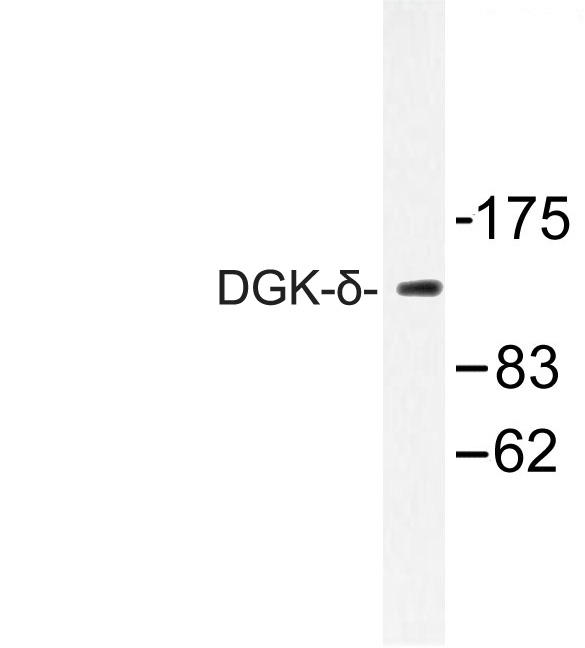DGKD Rabbit Polyclonal Antibody
Other products for "DGKD"
Specifications
| Product Data | |
| Applications | IF, IHC, WB |
| Recommended Dilution | Western blot: 1/500-1/1000. Immunohistochemistry on paraffin sections: 1/50-1/200. Immunofluorescence: 1/50-1/200. |
| Reactivities | Human |
| Host | Rabbit |
| Clonality | Polyclonal |
| Immunogen | Synthetic peptide, corresponding to amino acids 34-88 of Human DGK-δ. |
| Specificity | This antibody detects endogenous levels of DGK-δ protein. (region surrounding Ser66) |
| Formulation | Phosphate buffered saline (PBS), pH 7.2. State: Aff - Purified State: Liquid purified Ig fraction Preservative: 0.05% sodium azide |
| Concentration | 1.0 mg/ml |
| Purification | Affinity-chromatography using epitope-specific immunogen and the purity is > 95% (by SDS-PAGE). |
| Conjugation | Unconjugated |
| Storage | Store undiluted at 2-8°C for one month or (in aliquots) at -20°C for longer. Avoid repeated freezing and thawing. |
| Stability | Shelf life: one year from despatch. |
| Predicted Protein Size | ~ 135 kDa |
| Gene Name | Homo sapiens diacylglycerol kinase delta (DGKD), transcript variant 1 |
| Database Link | |
| Background | Diacylglycerol kinases (DGKs) phosphorylate diacylglycerol (DAG) to produce phosphatidic acid. DAG and phosphatidic acid are lipids that act as second messengers in signaling cascades. DGK-α influences cell activation and secretion of lethal exosomes, which in turn control cell death. DGK-β is abundant in restricted brain regions such as the caudate putamen and olfactory tubercle. DGK-γ encodes full-length and truncated transcripts that are present in a range of human tissues, with greatest expression observed in retina. DGK-δ is most abundant in skeletal muscle. DGK-ε shows specificity for arachidonylcontaining diacylglycerol and is expressed predominantly in testis. DGK-θ is most abundant in the cerebellum and hippocampus. DGK-ι is present in brain and retina as a predominant transcript of more than 12 kb, including a long 3-prime untranslated region, with additional low abundance transcripts of 9.5 and 7.5 kb. DGK-η is closely related to DGK-δ. DGK-ζ is most abundant in brain and muscle. DGKs have structural motifs that play regulatory roles, and these motifs form the basis for dividing the DGKs into five subtypes. |
| Synonyms | Diacylglycerol kinase delta,Diglyceride kinase delta, DGKD, KIAA0145, DGK-delta |
| Reference Data | |
| Protein Families | Druggable Genome |
| Protein Pathways | Glycerolipid metabolism, Glycerophospholipid metabolism, Metabolic pathways, Phosphatidylinositol signaling system |
Documents
| Product Manuals |
| FAQs |
| SDS |
{0} Product Review(s)
0 Product Review(s)
Submit review
Be the first one to submit a review
Product Citations
*Delivery time may vary from web posted schedule. Occasional delays may occur due to unforeseen
complexities in the preparation of your product. International customers may expect an additional 1-2 weeks
in shipping.






























































































































































































































































 Germany
Germany
 Japan
Japan
 United Kingdom
United Kingdom
 China
China



